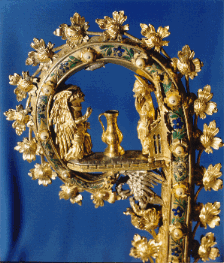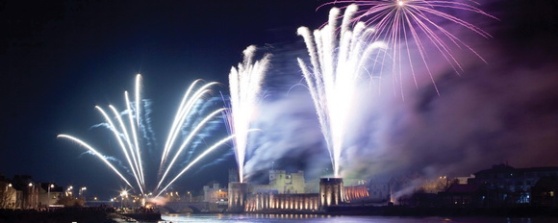Growing up in Ireland, I was completely convinced that the passage of the old year into the new year was very much about the strokes of midnight, perhaps a bell or two ringing, and everybody singing Auld Lang Syne out of tune. How very Anglo-American. Indeed, my favourite activity was watching the New Year Concert broadcast from the Vienna Philharmonic on New Year’s Day. I was entirely unaware that we Irish had any traditions on a par with the Italian one of disposing of one’s unwanted crockery by chucking it out the window at midnight. (I can imagine the casualty figures for Italian hospitals on New Year’s Day.) One custom did come to prominence in Ireland in the late 20th century – Dubliners gathered around Christchurch Cathedral to hear the bells ring in the New Year. And that was it, until the Millenium, when fireworks began to feature in celebrations all around the country.

A custom developed in Dublin of gathering around Christchurch Cathedral to hear the bells ring in the New Year.
Today’s Irish Times newspaper has published an interesting article on the traditions surrounding New Year in Ireland. The author of the article, Eilis Ni Dhuibhne, has focused on certain folk customs that I never heard of. They are worth considering, even though there is nothing in her choice as bizarre as the Germans staying in to watch an old British black and white comedy called Dinner for One.
Eilis starts off by delving into the vast folklore archive in UCD to discover that the most popular activity on New Year’s Day was …… doing nothing. Literally. She notes a source from Cavan in the early 1940s saying that you couldn’t bring anything out of the house on New Year’s Day. You couldn’t spend any money either. Anyone entering the house had to bring something. If they didn’t bring something on entering the house, the place would be empty (short of food, money, goods) throughout the year. But to complicate matters, people were afraid to give you anything on that day for fear that they were giving their luck away! So you see, the safest thing to do was……nothing. That way you avoided giving away your luck for the year, and nobody would want to do that, would they?

A covered well in the Burren – water could only be brought into the house before sundown on New Year’s Eve, and after sunrise on New Year’s Day.
A storyteller from Donegal recounted that no water should be brought into the house after sundown on New Year’s Eve. And no water, whether dirty or clean, could be removed from the house until after sunrise. This custom arose because New Year’s night was the anniversary of the Marriage at Cana where Jesus turned water into wine. Removing the water would remove the blessing of God upon the household. We’ll come back to this.
Another warning was that red-haired women were not welcome in the house on New Year’s Day. It seems tragic that the Maureen O’Hara type should be shunned in Ireland (!) at New Year, but there’s a reason for it. The thing is that until 1752, Britain and Ireland were out of step with most of Continental Europe which had switched to the Gregorian Calendar and the use of January 1st as New Year’s Day. Until that year, Britain and Ireland continued to follow the Julian Calendar despite the fact that it was running several days behind the astronomical year. And New Year’s Day was on 25th March, the Feast of the Annunciation. But in that year, Britain and ireland conformed to the modern calendar and moved New Year’s Day to the beginning of January. What on earth has this got to do with red-haired women on New Year’s Day?

The best medieval Irish depiction of the Annunciation is in the volute of the O’Dea crozier from Limerick. Made by the goldsmith Thomas O’Carryd in 1418 (when Good Friday fell on 25th March – the same day as the Annunciation!). This wonderful treasure is still in the possession of the Diocese of Limerick and is exhibited in the Hunt Museum.
Now think about this. The older tradition of celebrating New Year on 25th March was associated with the one of the first major feasts of the Virgin in the church calendar. The Annunciation celebrates the Virgin’s virtuous acceptance of the word fo God leading to the conception of Christ. Red haired women were associated with women of easy virtue – especially Mary Magdalene, who was wrongfully identified as a former prostitute by Pope Gregory the Great (died 604 AD). If you celebrated New Year on 25th March the last thing you wanted in your house was a red-haired woman, who, whatever her virtues, symbolized the very antithesis of the Virgin Mary! In short a red-haired woman might ruin any blessing emanating from the Feast of the Annunciation. When New Year moved to 1st January, the custom seems to have moved too, although it was now rendered meaningless.

Piero di Cosimo’s virtuous ‘Reading Magdalene.’ This poor saint has been wronged since the late 500s when Pope Gregory the Great identified her as a former prostitute – hence the red hair depicted by the artist. There is nothing in scripture to suggest that Mary Magdalene was a prostitute. She was certainly the first witness of the Resurrection.
And what about the marriage at Cana. This seems to have been associated with the Feast of the Annunciation so performing any funcition with water had to be done with respect on that day. Once again this custom moved to 1st January, losing any point it may have originally had.
One other thing to keep in mind. The Feast of the Annunciation often fell during Lent, a time of abstinence from certain foods (meat) and behaviour (sex). Keeping oneself virtuous in anticipation of Easter was considered important, and good for the soul. The abstinence from activity on New Year’s Day could fall into this. Essentially one abstained from work (including much housekeeping) in honour of the Feast of the Annunciation. This association was totally broken when the New Year moved to 1st January.
So you can see, we Irish are a bit confused about time – our New Year customs were designed to celebrated New Year on 25th March rather than on 1st January. We urgently need to develop new ‘traditions’!
A happy New Year to you all!


We leave dimes/coins outside for the angels to bless, at midnight. Irish tradition?
LikeLike
You will notice that the customs I mentioned in the post refer to sources in counties Cavan and Donegal. It is possible that many of these customs were rather localized. While I haven’t heard of leaving out coins for angels to bless, it may be a reference to some other tradition of leaving out gifts for spirits, the coins being a more sanitized version of such offerings.
LikeLike
Pingback: Redheads not invited…some bizarre Irish New Year customs. | homethoughtsfromabroad626